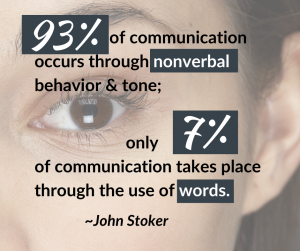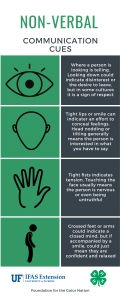 Last week, we shared Five ways to Cultivate Listening skills with 4-H youth. These strategies focused on listening with your ears, but did you know that you can listen with your eyes too? The quote to the left is an astounding fact- much of what we “hear” does not come from the words that are said, but how they are said. We use our whole body to communicate- not just our mouth and ears. Learning how to read non-verbal cues can help us (and the youth we serve) build empathy and understanding, which help us foster a sense of belonging in our 4-H clubs and groups.
Last week, we shared Five ways to Cultivate Listening skills with 4-H youth. These strategies focused on listening with your ears, but did you know that you can listen with your eyes too? The quote to the left is an astounding fact- much of what we “hear” does not come from the words that are said, but how they are said. We use our whole body to communicate- not just our mouth and ears. Learning how to read non-verbal cues can help us (and the youth we serve) build empathy and understanding, which help us foster a sense of belonging in our 4-H clubs and groups.
What are non-verbal cues?
Non-verbal communication is about how words are spoken and less about which words are used. This includes things like voice tone, pitch and pace. It can also include sounds like yawning, sighing, clapping and hand gestures. For example, someone may be speaking at a normal pace, but you can hear trembling in their voice (which may indicate fear or anger). Body language is a also a great communication cue. This includes not only facial expressions, but also posture. The infographic to the right is a handy guide for learning non-verbal communication cues.
Tips for “reading” non-verbal cues
- The eye’s have it! A person’s eyes speak volumes. Look to see if the speaking is making direct eye contact or not. Inability to make direct eye contact can indicate boredom or even deceit. But it can also indicate shyness or lack of confidence. In some cultures, not looking directly into a person’s eyes is a demonstration of respect and in other cultures, it is a sign of disrespect, so be aware of how cultural differences can influence body language. Where a person looks is telling. People often look to the right when they are using their imagination, but look left when they are recalling a memory.
- Facial expression is harder to detect, because most people focus on controlling it. Is the person smiling? If so, is it a genuine smile? Sarcastic smile? A slight grimace before a smile is usually the indicator of a fake smile. Tight lips can also indicate annoyance, whereas a relaxed mouth means a positive mood. Covering the face (especially the mouth) often indicates lying. Nodding the head usually means the person is interested, as is tilting the head to the side. Titling the head backwards can mean uncertainty.
- Hands can leak important information about another person’s thoughts and feelings. Hands in pockets can mean nervousness or even deception. Supporting the head with a hand means that the person is trying to focus on what is being said. Supporting the head with both hands means boredom.
- Stance and posture provide hints about a person’s attitude. If the person’s feet are pointed towards you, they have a good attitude towards what you are saying. If their feet or pointed towards someone else, that probably means they would rather be talking to that person (even if they are carrying on a conversation with you). In addition to looking at a person’s feet, notice how they are holding their arms. Crossed arms could indicate a closed mind, but crossed arms with a smile normally means that the person is confident and relaxed.
While these tips are helpful, they don’t apply 100% of the time, and should be used along with active listening to foster true understanding and healthy communication.
Strategies for teaching non-verbal communication skills
Take this 5-minute non-verbal communication quiz!
Brainstorm It!
- In one minute, have participants write down as many examples of nonverbal communication as they can.
- Go around the room and have people share their list, writing down all the examples. This part can be turned into a competition (inspired by the game Scattergories) by giving individuals get one point for each unique answer they have. (If no one else wrote down that same nonverbal cue they get a point.) The person(s) with the most points after everyone has shared wins!
- Review the list and group cues by the following categories:
-
- How words are spoken (tone, pitch, pace),
- Body language (gestures, facial expressions, posture),
- Non-language sounds (whistling, clapping, sighing),
- Visual cues (symbols, motions), and
- Tactile responses (touching)
Review and discuss. What type of cue was most commonly mentioned? What cues do you think have the most powerful communication? What cues could be misinterpreted?
The Power of Nonverbal
- Ask individuals to work in pairs. One person in the pair will be the designated speaker and the other person will communicate with nonverbal cues only. 2.) Challenge: The speaker will continue talking (about any subject) regardless of the cues the other person is giving to two minutes. The non-speaker will roll a dice to determine what message they will be giving off with nonverbal cues. (If the facilitator wants to keep the adjectives secret from the speaker, they can simply whisper the desired cue or have pre-labeled pieces of paper.)
- 1- Engaged – Super interested in what the speaker is saying!
- 2- Apathetic – Not interested one bit.
- 3- Angry – Very opposed to what the speaker is saying.
- 4- Distracted – Interested in speaker, but really need to go to the bathroom.
- 5- Distracted – Not very interested; anxiously waiting for a call, text, or email.
- 6- Tired – Exhausted and having difficulty concentrating.
- After two minutes, have the speaker try to guess what nonverbal cue was communicated.
- Switch roles and repeat for two additional minutes.
- Discuss and reflect on the impact nonverbal cues have on the speaker
Decipher the Message
- Search YouTube for some non-verbal communication video clips. Play the video so youth can observe examples of nonverbal communication. Some examples are linked below.
2. Discuss possible interpretations (starting with the participants’ perspectives) and describe why those interpretations are valid. (Share in small groups of 4-5 if the audience is more than 15 people. Each group can report back to the larger group.)
3. If there is an alternative interpretation, the facilitator can share it to emphasize the importance of context, culture, or other meaning in nonverbal communication.
- Meet our Summer Intern- Andy Franklin! - June 13, 2025
- Blue Ribbon Baked Goods - September 23, 2024
- Blue Ribbon Photos and Posters - September 21, 2024
